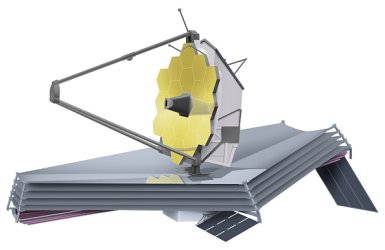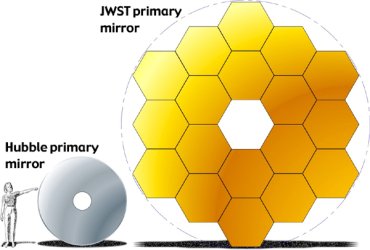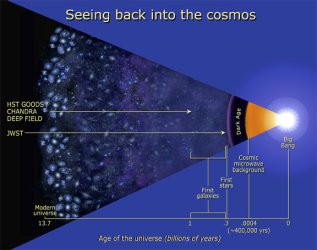The JWST, the long-awaited successor to the Hubble Space Telescope, will be 100 times as powerful than the Hubble. It will change how we see the universe. Webb’s gold-hued mirrors combine for a diameter of 21.3 feet allowing more than six times the light-collecting area of Hubble’s 7.8 foot mirror.
The Hubble Space Telescope collects visible light, ultraviolet, and some infrared. The Webb is primarily an infrared telescope, so it sees light that’s in a longer wavelength than what our eyes can see. This allows Webb to look further back in time than the Hubble.
Because the universe is expanding, the wavelengths of light from distant galaxies reaching us gets stretched, moving from blue to red, dropping into the infrared spectrum. Webb can see this ancient light that has become invisible to the human eye.


While Hubble was launched in an orbit 340 miles above Earth, Webb will be almost a million miles away at the Earth-Sun L2 Lagrange point — four times the distance from the Earth to the moon so it will be unserviceable by human hands if it breaks.
Because Webb is an infrared telescope, it needs to be kept cold - to minus 400 degrees Fahrenheit - so it has a sun shield, 69.5 ft x 46.5 ft, the size of a tennis court that acts as a giant beach umbrella. At the L2 point, Webb's solar shield will block the light from the Sun, Earth, and Moon.
With Webb, astronomers will be able to see so far back that they’ll potentially spot the very first stars and galaxies. Hubble has seen light dating to about 400 million years after the Big Bang, which took about 13.3 billion years to reach us. Webb has the capability to take us to 250 million years after the Big Bang (exact timings are still being researched). Originally scheduled for launch in 2010 at a cost $1 billion, its price tag has ballooned to $10 billion.

The largest space telescope in history is about to blow our minds
The Hubble Space Telescope collects visible light, ultraviolet, and some infrared. The Webb is primarily an infrared telescope, so it sees light that’s in a longer wavelength than what our eyes can see. This allows Webb to look further back in time than the Hubble.
Because the universe is expanding, the wavelengths of light from distant galaxies reaching us gets stretched, moving from blue to red, dropping into the infrared spectrum. Webb can see this ancient light that has become invisible to the human eye.


While Hubble was launched in an orbit 340 miles above Earth, Webb will be almost a million miles away at the Earth-Sun L2 Lagrange point — four times the distance from the Earth to the moon so it will be unserviceable by human hands if it breaks.
Because Webb is an infrared telescope, it needs to be kept cold - to minus 400 degrees Fahrenheit - so it has a sun shield, 69.5 ft x 46.5 ft, the size of a tennis court that acts as a giant beach umbrella. At the L2 point, Webb's solar shield will block the light from the Sun, Earth, and Moon.
With Webb, astronomers will be able to see so far back that they’ll potentially spot the very first stars and galaxies. Hubble has seen light dating to about 400 million years after the Big Bang, which took about 13.3 billion years to reach us. Webb has the capability to take us to 250 million years after the Big Bang (exact timings are still being researched). Originally scheduled for launch in 2010 at a cost $1 billion, its price tag has ballooned to $10 billion.

The largest space telescope in history is about to blow our minds
